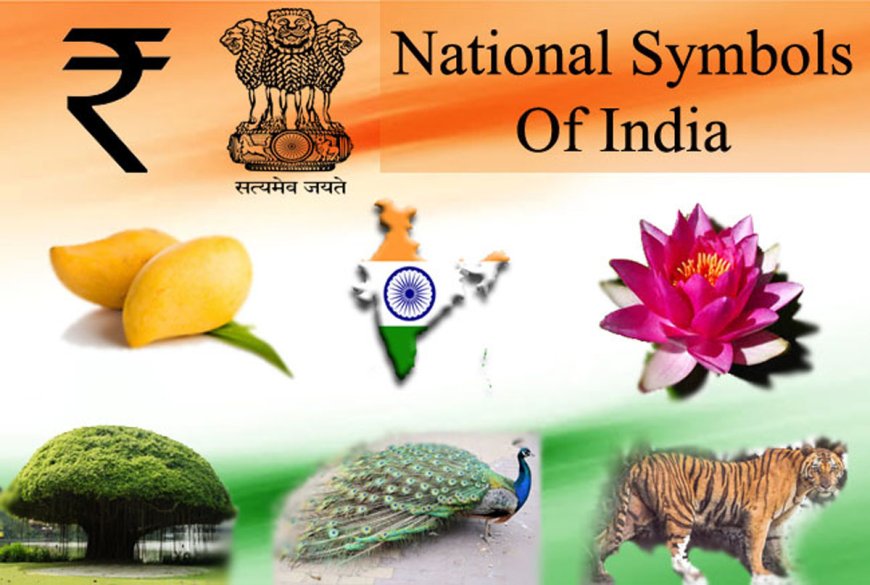National Symbols of India
National Symbols of India are the culture and pride of our country. There are total 17 National Symbols. Our nation’s heritage and pride are represented by its symbols. These 17 national symbols of India symbolize the culture and tradition of the country, which we Indians spread around the globe. These symbols are also required since they are of national significance and need to be known by all citizens.
1. National Flag- Tiranga
2. National Emblem- Lion Capital of Ashoka at Sarnath
3. National Currency- Indian Rupees
4. National Calendar- Saka Calendar
5. Oath of Allegiance- National Pledge
6. National River- Ganga
7. National Heritage Animal- Indian Elephant
8. National Animal- Royal Bengal Tiger
9. National Bird- Indian Peacock
10. National Tree- Indian Banyan Tree
11. National Song- Vande Mataram
12. National Anthem- Jana Gana Mana
13. National Game- Hockey
14. National Aquatic Animal- Ganges River Dolphin
15. National Vegetable- Pumpkin
16. National Fruit- Mango
17. National Flower- Lotus.
Importance of National Symbols of India
1. National Flag: Tiranga
The Hindi word “Tiranga” which translates to “containing three colors,” is used to describe the national flag of India. This multicolored flag represents India’s freedom and sovereignty and features a wheel of law in the centre.
2. National Emblem of India: Lion Capital of Ashoka at Sarnath
Four lions are pictured on the summit of an Ashokan pillar at Sarnath, near Varanasi, in the Uttar Pradesh state. Its base has the Dharma Chakra, also known as the Wheel of Law, with carvings of an elephant, a horse, a bull, and a lion spaced apart by intervening wheels over a bell-shaped lotus. The Indian Government designated this symbol as its National Emblem on January 26, 1950.
3. National Currency: Indian Rupees
The national currency of India is the rupee, or INR. Currency circulation is monitored by the Reserve Bank of India. The Indian rupee was created by Udayakumar Dharmalingam.
4. National Calendar: Saka Calendar
Shalivahana Shaka calendar/Saka Calendar is the national calendar; it signifies the history of the country and symbolizes the golden era of India.
5. Oath of Allegiance: National Pledge
Oath of Allegiance is the the national pledge of India. The nation is kept peaceful, united, and brotherly by the national anthem.
6. National River: Ganga
The Ganges is a lifeline to millions who live along its course.It is a sacred river and worshipped as the goddess Ganga in Hinduism.
7. National Heritage Animal: Indian Elephant
The Indian Elephant is the country’s national heritage animal. The elephants are on the verge of being extinct therefore the protective major was taken and the Indian Elephant was declared the national heritage animal.
8. National Animal: Royal Bengal Tiger
The Tiger, Panthera tigris (Linnaeus), is well recognized for his royal grace, prodigious grandeur, and tremendous strength. Eight native species of tigers may be found in India, which is home to more than half of the world’s tiger population.
9. National Bird: Indian Peacock
The Indian Peacock has earned the honor of serving as the country with the largest democracy in the world’s national bird. Pavo cristatus is the scientific name for the species. Peacocks have long been a part of Indian mythology and a symbol of monarchy and divinity because of their grace, pride, spirituality, and beauty.
10 National Tree: Indian Banyan tree
The Banyan tree, Ficus bengalensis, is India’s national tree. The Banyan, a member of the fig family, spread over a broad region, takes root, and continues to live and regenerate for thousands of years.
11. National Song: Vande Mataram
“Vande Mataram” was written by Bankim Chandra Chaterjee for his Bengali book “Anand Math.” The song, which was bursting with patriotic passion and admiration for the motherland, quickly became a favorite among the era’s independence warriors.
12. National Anthem: Jana Gana Mana
The song “Jana-gana-mana” has five stanzas, all of which were written by renowned Indian poet and Nobel laureate Rabindranath Tagore. It was performed for the first time on December 27, 1911, in Calcutta during a meeting of the Indian National Congress in the then-colonial India.
13. National Game: Hockey
Hockey has maintained its status as India’s national sport despite cricket’s rising popularity. The Indian hockey team reached its pinnacle between 1928 and 1956, winning all six of those years’ consecutive Olympic gold medals.
14. National Aquatic Animal: Ganges River Dolphin
Due to a decline in dolphin populations over the previous few years, the Ganges river dolphin is recognized as the country’s official aquatic animal. As a result, it was designated as the national aquatic animal to protect them.
15. National Vegetable: Pumpkin
16. National Fruit: Mango
Indians have long referred to ripe, meaty mangoes as the King of all fruits, and they are undoubtedly delicious. Spiced pickles, a staple of Indian cuisine, can be made from the raw ones. Mangoes are the most widely cultivated fruits in the tropical world and are native to India. They are members of the Mangifera indica species.
17. National Flower: Lotus.
Lotus (Nelumbo Nucifera Gaertn) is the National Flower of India. It is a sacred flower and occupies a unique position in the art and mythology of ancient India and has been an auspicious symbol of Indian culture since time immemorial.



























































